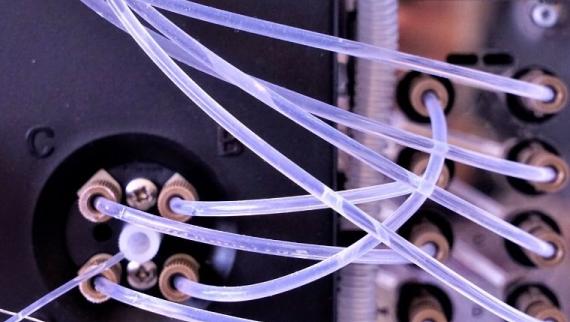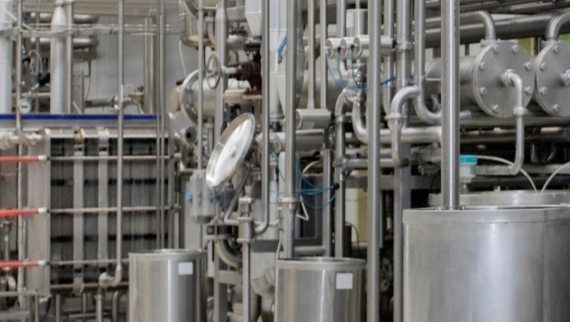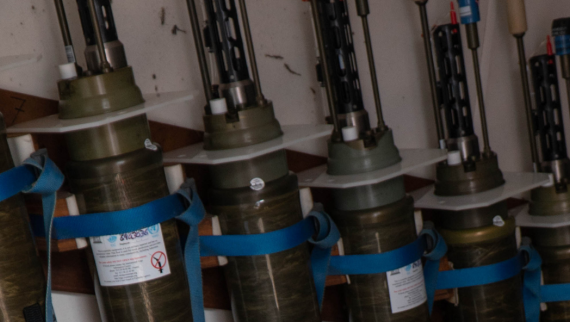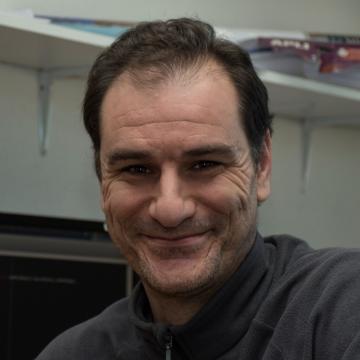Biosystem & Bioprocesses Engineering
From mathematical modeling and computer-aided simulation to design, control and optimization of bioprocesses and biological systems.
The world around us can be explained to a great extent by understanding the systems that compose it and the processes that connect them.
The IIM-CSIC's Biosystem & Bioprocess Engineering group seeks to develop new methods and tools (mainly software) for process systems engineering, which enable the simulation, optimization and control of bioprocesses, such as those involved in food processing and preservation and in industrial biotechnology.
The group applies process systems engineering methods to improve the efficiency of key industrial processes, reducing their environmental impact and improving the quality and safety of their products.
Its focus is model identification, optimization, monitoring and robust control of non-linear dynamic systems, including distributed parameter systems (convection-diffusion-reaction). The group considers a broad spectrum of applications, namely fisheries management, food processing, quality and safety—including antimicrobial resistance—and industrial biotechnology.
- PERIZIA -
Conservación y explotación sostenible de las poblaciones de erizo mediante tecnologías innovadoras basadas en inteligencia artificial
Principal investigator:TaboadaAnteloLuisFunding body:Proyecto financiado por el Programa Pleamar de la Fundación Biodiversidad, cofinanciados por el Fondo Marítimo de Pesca y de Acuicultura (FEMPA)Funding for IIM-CSIC:303205€Go to project pageFromto - GELFISH -
Producción de oleogeles marinos para la valorización de descartes hacia una pesca costera artesanal sostenible
Principal investigator:TaboadaAnteloLuisFunding body:Proyecto financiado por el Programa Pleamar de la Fundación Biodiversidad, cofinanciados por el Fondo Marítimo de Pesca y de Acuicultura (FEMPA)Funding for IIM-CSIC:351378€Go to project pageFromto - PreCalA -
<p>Programa Ciencias Mariñas: Ferramentas para a predición da calidade en productos da acuicultura</p>
Principal investigator:VilasFernándezCarlosFunding body:El Programa de Ciencias Mariñas de Galicia es 1 de los 5 programas de Ciencias Marinas de los Planes Complementarios de I+D+I del Plan de Recuperación Transformación y Resilencia. Financiado por FEMP/FEMPA.Funding for IIM-CSIC:100281€Go to project pageFromto - DigitAlg -
<p>Programa Ciencias Mariñas: Xemelgo dixital do cultivo de algas na acuicultura multitrófica integrada</p>
Principal investigator:BalsaCantoEvaFunding body:El Programa de Ciencias Mariñas de Galicia es 1 de los 5 programas de Ciencias Marinas de los Planes Complementarios de I+D+I del Plan de Recuperación Transformación y Resilencia. Financiado por FEMP/FEMPA.Funding for IIM-CSIC:122667€Go to project pageFromto - ATOPES -
<p>Programa Ciencias Mariñas: Aplicación de Tecnoloxías Innovadoras para a Obtención de Datos Pesqueiros</p>
Principal investigator:TaboadaAnteloLuisFunding body:El Programa de Ciencias Mariñas de Galicia es 1 de los 5 programas de Ciencias Marinas de los Planes Complementarios de I+D+I con las CCAA del Plan de Recuperación Transformación y Resilencia (NextGenerationEU).Funding for IIM-CSIC:137391€Go to project pageFromto
- Pedreira, A.; Vázquez, J.A.; García, M.R. (2022) Kinetics of Bacterial Adaptation, Growth, and Death at Didecyldimethylammonium Chloride sub-MIC Concentrations Frontiers in Microbiology DOI:10.3389/fmicb.2022.758237
- Ovalle, J.C.; Vilas, C.; Antelo, L.T. (2022) On the use of deep learning for fish species recognition and quantification on board fishing vessels Marine Policy DOI:10.1016/j.marpol.2022.105015
- González, P.; Osorio, R.R.; Pardo, X.C.; Banga, J.R.; Doallo, R. (2022) An efficient ant colony optimization framework for HPC environments Applied Soft Computing Journal DOI:10.1016/j.asoc.2021.108058
- Otero-Muras I; Banga JR (2021) Synthetic Gene Circuit Analysis and Optimization " Computational Methods in Synthetic Biology" Humana Press / Springer ISBN:978-1-0716-0822-7
- Otero-Muras I; Banga JR (2021) Automated Biocircuit Design with SYNBADm " Synthetic Gene Circuits" Springer ISBN:978-1-0716-1031-2
- TFM - Andrea Arribas Jimeno (26/09/2022) Aplicabilidad de la tecnología de imágenes hiperespectrales (HSI) como método no invasivo para la evaluación de la calidad del pescado UNIVERSIDAD DE SANTIAGO DE COMPOSTELA
- TFM - Artai Rodríguez Moimenta (19/07/2020) Desarrollo de un modelo de corte mecanístico que permita describir un proceso de fermentación mixta Universidad de Vigo (UVigo)
- TFG - Laura Honrubia Baamonde (11/07/2019) Optimization of Benzalkonium Chloride treatment in the disinfection of L. Monocytogenes in the Food Industry UNIVERSIDAD DE LLEIDA
- TFM - Pablo de la Torre Fernández (20/09/2018) Modelado del proceso de fermenatición vínica: co-cultivo de especies no convencionales Universidade da Coruña
- PhD - Alejandro López Núñez (18/07/2018) CONTRIBUTIONS TO MATHEMATICAL MODELLING AND NUMERICAL SIMULATION OF BIOFILMS UdC
- WASHTOP -
<p>Water Associated Safety Hazards in the Treatment of Produce</p>
Principal investigator:RodríguezGarcíaMíriamFunding body:European Food Safety Authority (EFSA)Funding for IIM-CSIC:80000€Go to project pageFromto
- Capabilities | Development of intelligent sensors for the optimization of food processing and conservation
Development of non-invasive methods and technologies (i.e. hyperspectral imaging technology) for quality inspection of food products.
- Capabilities | Development of integrated plant-wide control and optimization for food industry
Multi-scale modeling for flexible decision-making and optimization of complex processes (i.e., sterilization) based on safety and quality control of food products using non-invasive techniques (software sensors, etc).
- Capabilities | Design of disinfection procedures and modeling for the prevention of antimicrobial resistance
Development of chemical (combinations of disinfectants, essential oils) and biological (enzymes, phages) strategies that are effective for removing monospecific and mixed microbial biofilms from surfaces in the food industry. Biocide testing and development of better biocide dosage strategies for the food industry, ensuring food safety while avoiding antimicrobial resistance acquisition.
- Capabilities | Modeling and optimization of fermentative processes and other bioprocesses with industrial utilization
Development of mathematical algorithms and simulation software for global optimization and control of bioprocesses in the food and biotechnological industry
- Capabilities | Assessment of nutritional value in seafood and design of personalized nutrition treatments and products
Design and development of seafood products for target consumers (elderly, young, diabetic, allergic to seafood, etc.) that guarantee specific nutritional requirements, safety and sustainability. Development of techniques (i.e. metabolomics, proteomics, genomics, lipidomics, etc.), using animal models and cell cultures, to characterize the response of a patient/consumer to diet and to design personalized nutrition treatments and products (i.e. nutraceutics, hypoallergenic fish products, immunostimulants, functional foods, etc).
- Software | MIDER: a toolbox for network inference using mutual information distance and entropy reduction
MIDER (mutual information distance and entropy reduction) is a general purpose software tool for inferring network structures. It has been developed with biological networks in mind but can be applied to other areas.
More information here.
- Software | MEIGO: a multiplatform toolbox for Global Optimization using Metaheuristics
MEIGO is a global optimization toolbox that includes a number of metaheuristic methods, as well as a Bayesian inference method for parameter estimation.
More information here.
- Software | SSm GO toolbox: Scatter Search for Global Optimization in Matlab
SSm GO is a Matlab toolbox with several global optimization algorithms for nonlinear optimization problems (NLPs and MINLPs) based on Scatter Search.
More information here.
- Software | Model-based design of smart active packaging systems with antimicrobial activity
Matlab code to perform simulations and optimize packaging design using natural antimicrobials (carvacrol) for hake (Merluccius merluccius). In addition, different polymers are considered as possible active packaging materials.
More information here.
- Software | DOTcvpSB: Matlab toolbox for Dynamic Optimization in Systems Biology
DOTcvpSB is a toolbox written in MATLAB that uses the control vector parameterization (CVP) method to handle continuous and mixed integer dynamic optimization problems. DOTcvpSB has been successfully applied to several problems in systems biology and bioprocess engineering.
More information here.















